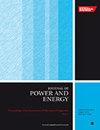残炭对深氧阶段条件下高碱准东煤灰熔特性影响的试验研究
IF 1.1
4区 工程技术
Q3 ENGINEERING, MECHANICAL
Proceedings of the Institution of Mechanical Engineers, Part A: Journal of Power and Energy
Pub Date : 2024-08-22
DOI:10.1177/09576509241277241
引用次数: 0
摘要
由于氧气阶段较深,煤粉在一次燃烧区不能完全燃烧,导致残炭含量较高。灰渣中的残炭对灰渣的熔融特性有潜在的影响,而残炭对高碱煤灰渣熔融特性的影响还缺乏专门的研究。本研究将合成灰与残炭混合,研究残炭含量、残炭石墨化程度和大气条件对灰熔融特性的影响。使用热重分析仪和灰熔点测试仪研究了灰的热重行为和灰熔融的特征温度,然后使用 X 射线衍射仪和扫描电子显微镜分析了矿渣矿物成分和微观形态的变化。实验结果表明,残炭含量的变化对灰渣中结晶矿物种类的影响较小,而对各种矿物相对含量的影响较大。掺入活性炭和石墨的灰的软化温度分别为 1234°C 和 1242°C。活性炭的掺入极大地促进了gehlenite(Ca2Al2SiO7,1593°C)的生成,抑制了merwinite(Ca3MgSi2O8,1550°C)的生成,从而提高了灰熔化温度。纯合成灰的灰熔融特征温度随着还原气氛的增强而降低。然而,与弱还原气氛相比,在强还原气氛中掺入碳的灰熔融特性温度会升高,这是因为部分碳起到了骨架的作用,或发生反应形成了碳硅化合物。本研究可为高碱准东煤在深氧阶段条件下的燃烧和利用提供基础支持。本文章由计算机程序翻译,如有差异,请以英文原文为准。
Experimental study on the effects of residual carbon on ash fusion characteristics of high-alkali Zhundong coal under deep oxygen-staged condition
Due to the deep stage of oxygen, the pulverized coal cannot be burned completely in the primary combustion zone, resulting in a high content of residual carbon. The residual carbon in ash has a potential effect on the melting characteristics of ash, while there is a lack of specific research on the effects of residual carbon on ash fusion characteristics of high-alkali coals. In the present study, synthetic ash was blended with residual carbon to study the impacts of residual carbon content, graphitization level of the carbon, and atmospheric condition on ash fusion characteristics. Thermogravimetric analyzers and ash melting point testers were used to study the thermogravimetric behavior of ash and the characteristic temperatures of ash fusion, and then analyze the changes in the mineral composition and micromorphology of slag using X-ray diffractometers and scanning electron microscopy. The experimental results reveal that the change in residual char content exerts a minor influence on the type of crystalline minerals within the ash, while it affects the relative content of various minerals. The softening temperature of the ash blended with activated carbon and graphite are 1234°C and 1242°C, respectively. The blending of activated carbon greatly promotes the generation of gehlenite (Ca2Al2SiO7, 1593°C) and inhibits the generation of merwinite (Ca3MgSi2O8, 1550°C), increasing the ash melting temperature. The ash fusion characteristic temperatures of the pure synthetic ash decrease with the enhancement of the reductive atmosphere. However, the ash fusion characteristic temperatures of the ash blended with carbon in strong reducing atmosphere are increased compared to those in weak reducing atmosphere because part of the carbon acts as a skeleton or reacts to form a carbon-silicon compound. The present study can offer improved knowledge to provide fundamental support for the combustion and utilization of high-alkali Zhundong coal under deep oxygen-staged conditions.
求助全文
通过发布文献求助,成功后即可免费获取论文全文。
去求助
来源期刊

CiteScore
3.30
自引率
5.90%
发文量
114
审稿时长
5.4 months
期刊介绍:
The Journal of Power and Energy, Part A of the Proceedings of the Institution of Mechanical Engineers, is dedicated to publishing peer-reviewed papers of high scientific quality on all aspects of the technology of energy conversion systems.
 求助内容:
求助内容: 应助结果提醒方式:
应助结果提醒方式:


